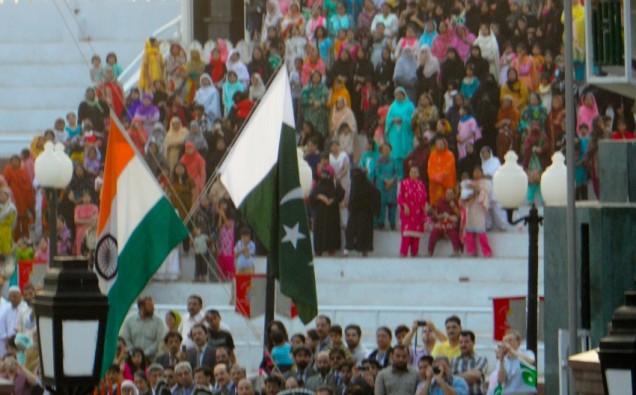
Indian Prime Minister Narendra Modi’s unannounced visit to Pakistan last week has given rise to a wave of unending speculations and readings into the future course of relations between the two often-tense South Asian nuclear-armed neighbors.
Was it a pre-planned trip that saw Pakistani Prime Minister Nawaz Sharif host Modi in his Raiwind in Lahore area for a meeting on the occasion of Sharif’s birthday as well as a wedding ceremony of the Pakistani leader’s granddaughter? Or was it just a stopover that took place at Modi’s request on his way back from Afghanistan to India? Indian External Affairs Minister Sushma Swaraj’s visit to Islamabad and meetings with top Pakistani leaders earlier this month appear to have paved the way for Modi’s stop in Lahore.
Modi’s visit is important in the backdrop of this year’s tensions between the two countries and heavy shelling across the Line of Control in disputed Kashmir region. It is also reminiscent of a 1999 winter visit to Lahore by another BJP leader and Indian Prime Minister Atal Behari Vajapayee. Contrastingly with the quietness of Modi’s 2015 visit, a flock of media persons, both foreign and Pakistanis, was taken to Wagha India-Pakistan border from a five star hotel of Lahore and dropped at the Joint Check Post , about two hours before the bus carrying Vajpayee crossed Wagah Border Zero Line to enter Pakistani soil.
When Vajpayee, his Foreign Minister Jaswant Singh and film stars Dev Anand, Shabana Azami and Shatroghan Sinha alighted from the bus, the atmosphere was filled with a strange feeling of festivity. During that visit , Indian leader addressed Pakistani intelligentsia at Governor’s House Lahore and recited his well-acclaimed poem, ‘Jang Honey Nahin Dain Gey (We will not let war take place).
Vajpayee also visited Minar-e-Pakistan that marked the recognition of creation of Pakistan by right wing leaders who had opposed the division of Subcontinent in 1947. The visit ended with the signing of Lahore declaration that promised peace in South Asia. Through, the Kargil conflict came as a huge setback and poured cold water on Lahore declaration. The October 12, 1999 military coup was the last nail in the coffin of Lahore declaration peace effort, although the two countries were able to launch a composite peace process several years later under Vajpayee and Pervez Musharraf.
Now, 17 years later, Modi, who belongs to right wing Bharatiya Janata Party, made a visit to Pakistan, which currently is seen as goodwill gesture. Away from the media glare, the two prime ministers met, leading to a flood of interpretations of all kinds. Social media websites were rife with all sorts of conspiracy theories from both Indians and Pakistanis. Some termed the Sharif-Modi meeting a business activity as a steel tycoon from India , Sajjan Jindal was also present at Raiwind residence of Nawaz Sharif , apparently to attend the wedding ceremony of Pakistani Prime Minister’s granddaughter. Right wing politico-religious parties like Jamaat-e-Islami called the meeting a sell-out of national interests especially those related to longstanding Kashmir issue. Some analysts called the visit an outcome of US pressure on the Indian leadership to reconcile with Pakistan. It was the official word from the foreign offices in New Delhi and Islamabad that made things a little bit clearer next morning. But India’s search for trade routes to Afghanistan and Central Asia could also be important factors.
Last week’s meeting between the leaders of regional rivals and two largest South Asian economies is the third over the last five months. Sharif had visited New Delhi in May 2014 for inaugural ceremony of the Modi as head of the new government emerging from that year’s election.
Modi’s surprise visit to Lahore has a special significance at a time when the Pakistan-India relations have been severely hit by the LoC violations in Kashmir. The beef ban controversy in India that has resulted in a number of lynching deaths of Indian Muslims, has also had negative repercussions. Other issues that have dogged peace prospects in recent years include 2007 Samjhota Express train arson, 2008 Mumbai attacks, and India’s continued repression of the Kashmiris.
The immediate positive outcome of this meeting lies in resumption of talks. Initially, foreign secretaries will hold talks on January 15, 2016. The secretarial level meeting may contemplate Modi’s visit to Pakistan. Given contradictions of his policies and ability to spring surprises, Modi’s venture to Pakistan, has had two broad implications: First, it has bought down political temperatures in Pakistan-India equation. Secondly, it has opened a range of possibilities for restoration and advancement of peace and trade processes between the two nations – something that will help achieve stability in the broader region.
How the two countries overcome their acrimonious past, will depend on sustainability of parleys, and how the two countries make amends for their mistakes. The beneficiaries will include not only millions of Pakistani and Indian citizens but also Afghans and the people of Jammu and Kashmir.
FEATURED IMAGE on top of the post shows a lowering of flags at Wagah land crossing between Pakistan and India. Photo Credit : Daniel Hauptstein via Wikimedia Commons














